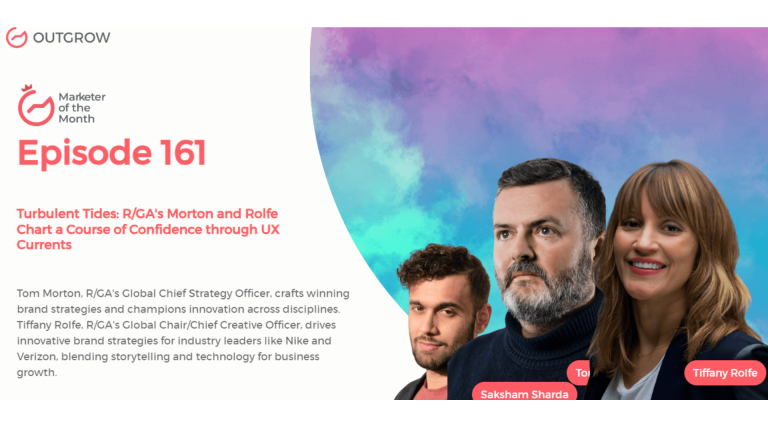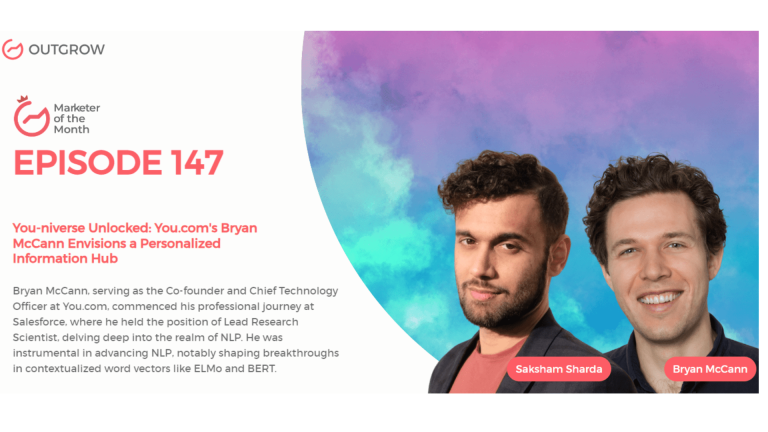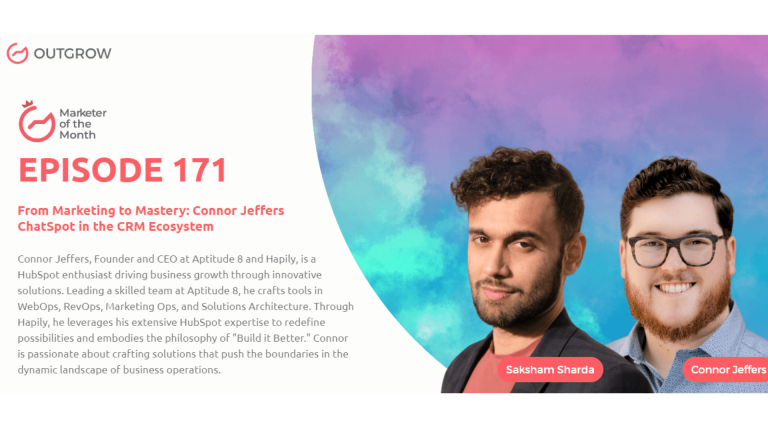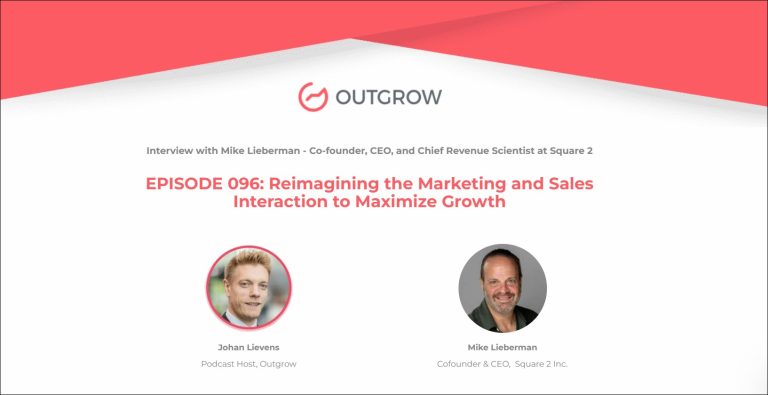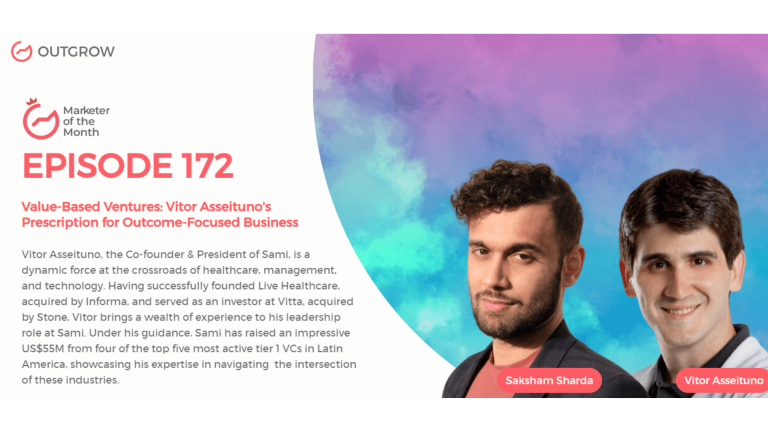EPISODE 089: Marketer of the Month Podcast with Brendan Hufford
Table of Contents
Hey there! Welcome to the Marketer Of The Month blog!
We recently interviewed Brendan Hufford for our monthly podcast – ‘Marketer of the Month’! We had some amazing insightful conversations with Brendan and here’s what we discussed about –
1. Why traditional B2B marketing attribution is broken and what you can do about it
2. The growing reliance on AI
3. Boosting customer acquisition for SaaS through a freemium model
4. The key to building long-term relationships
5. Aligning customer expectations, values, and outcomes
6. Why business writing is important in addition to building a trustworthy internet presence
About our host:
Dr. Saksham Sharda is the Chief Information Officer at Outgrow.co. He specializes in data collection, analysis, filtering, and transfer by the means of widgets and applets. Interactive, cultural, and trending widgets designed by him have been featured on TrendHunter, Alibaba, ProductHunt, New York Marketing Association, FactoryBerlin, Digimarcon Silicon Valley, and at The European Affiliate Summit.
About our guest:
Brendan Hufford is the Founder of Growth Sprints and Growth Marketer at ActiveCampaign. After spending the first decade of his professional career as a high school teacher (and assistant principal), Brendan led the SEO team at two agencies. In 2021, he founded Growth Sprints where he works with SaaS companies, helping them scale from $10M to $100M ARR.
Building a Marketing Funnel That Understands Your Audience
The Intro!
Saksham Sharda: Hi, everyone. Welcome to another episode of Outgrow’s Marketer of the Month. I’m your host, Dr. Saksham Sharda. I’m the creative director at Outgrow.co And for this month we’re going to interview Brendan Hufford, who is the founder of Growth Sprints, which is an agency that helps companies acquire customers. Thanks for joining us, Brendan.
Brendan Hufford: Yeah, thanks so much for having me. It’s gonna be great.
Don’t have time to read? No problem, just watch the Podcast!
Or you can just listen to it on Spotify!
The Rapid Fire Round!
Saksham Sharda: So Brendan, we’re going to start with a rapid-fire round just to break the ice. You get three passes. In case you don’t want to answer the question. You can just say pass. But try to keep your answers to one word or one sentence only. Okay?
Brendan Hufford: You got it.
Saksham Sharda: All right. So the first one is at what age do you want to retire?
Brendan Hufford: Tomorrow
Saksham Sharda: How long does it take you to get ready in the mornings?
Brendan Hufford: 30 seconds.
Saksham Sharda: Most embarrassing moment of your life?
Brendan Hufford: Dropping everything off of my lab table in 10th-grade chemistry class.
Saksham Sharda: Favorite color?
Brendan Hufford: Blue
Saksham Sharda: What time of day are you most inspired?
Brendan Hufford: First thing in the morning before people wake up.
Saksham Sharda: How many hours of sleep can you survive on?
Brendan Hufford: Four or five.
Saksham Sharda: Fill in the blank: An upcoming marketing trend is ________.
Brendan Hufford: Talking to customers.
Saksham Sharda: The city in which the best kiss of your life happened?
Brendan Hufford: Kendallville Indiana
Saksham Sharda: Pick one: Mark Zuckerberg or Jack Dorsey?
Brendan Hufford: I don’t know either of them that well, right? I don’t think Jack Dorsey is a robot. So Jack Dorsey.
Saksham Sharda: The biggest mistake of your career?
Brendan Hufford: Joining a company that I knew had a toxic culture.
Saksham Sharda: How do you relax?
Brendan Hufford: Reading
Saksham Sharda: How many cups of coffee do you drink per day?
Brendan Hufford: How big is a cup?
Saksham Sharda: Doesn’t matter. It’s only a rapid fire. So you have to say.
Brendan Hufford: This cup that I’m holding up is the size of my face. So if that’s the size, then one but I’m pretty sure there are about five times in one part of the house.
Saksham Sharda: Okay, a habit of yours that you hate?
Brendan Hufford: Biting my nails.
Saksham Sharda: The most valuable skill you’ve learned in life?
Brendan Hufford: Empathy.
Saksham Sharda: And the last one is your favorite Netflix show?
Brendan Hufford: Mad Men
Saksham Sharda: Okay, well, that’s the end of the rapid-fire round, and you scored 10/10. Because you did kind of manage to answer all of them even though you almost didn’t answer the Zuckerberg and Dorsey one.
Brendan Hufford: No, no passes, but I can’t guarantee we keep it to one sentence.
The Big Questions!
Saksham Sharda: Cool. Okay, so let’s go on to the long-form questions which you can answer with as much detail as you’d like. And the first one is, would you agree with the statement that new technologies bring businesses, and opportunities, but the constants are the ones responsible for creating delightful customer experiences, reviewing the analytics, and fueling the next marketing experiments?
Brendan Hufford: So the clarifying question here is, are you essentially asking if the new technology is great for bringing in new business and things like that? But there are still like mainstays that we shouldn’t throw away as we like, chase this thing?
Saksham Sharda: Yeah.
Brendan Hufford: Yeah, I think just by my reframing and re-asking the question, that’s absolutely something that I believe in. I think there are things that new technologies have made incredible, help marketers and businesses make incredible progress, right, businesses survived the onset of the pandemic in 2020, especially restaurants because they were able to use technologies like toast or something similar to immediately spin up a delivery service or immediately spin up a pickup or to go capability. So things like that are amazing. However, I think sometimes it’s very easy to get so excited about those that you forget the other pieces of what used to work. Then there’s a lot of talk about attribution, in marketing and my world, and a lot of people are really hot on self-reported attribution. Again, it came around full circle, like originally, when you got a customer, you’d be like, How’d you hear about us? And it was like a very important touch point thing to ask them. Then eventually we’re like, we don’t need to ask that. The software tells us and now we’re kind of you know, The pendulum swinging back the other way where people are like, yeah, the software’s wrong a lot. So we should probably be doing both, right? They’re both flawed. But this old thing also is really important.
Saksham Sharda: And so like attribution, what is something else that has come back with a force?
Brendan Hufford: I feel like I’m talking about “talking to customers” a lot lately. And I don’t think that should be a surprising thing. But having worked inside of a really big SaaS company, and also consulted with a lot of them, my customers are super siloed. Coming back to that has been super important. And there’s a classic book called Breakthrough Advertising by Eugene Schwartz. And Eugene Schwartz talks about these levels of awareness – problem aware, solution aware, product awareness, and most aware, also talks about being completely unaware of any sort of problem existing. Those are like coming back in and are super important to the work that we do as well. So things like that there’s another cool study that I think is like 25 years old, so not super old, but just not a lot of people know about the science of curiosity. And for the work that I do in marketing, understanding how to harness people’s creativity and harness curiosity is the whole name of the game. And there’s like five curiosity levers that you can pull that’s coming back around again. I think a lot of times we fetishize this old stuff. Everybody gets all up on Scientific Advertising and Eugene Schwartz and David Ogilvy and all these things. And there’s a lot of gold in there. Don’t get me wrong, my most highlighted book on my Kindle right here is Ogilvy on advertising. I share quotes from it constantly. However, I think that having that mix in that balance of like, I’m going to study the things that have not changed. It’s weird advertising copywriting, a lot of that still holds buyer psychology. But also mixing in the new I think is super important.
Saksham Sharda: And so could you share a quote from Ogilvy that you like?
Brendan Hufford: Yes, Have you ever heard of Readwise?
Saksham Sharda: Not quite
Brendan Hufford: Readwise is this beautiful app that I would pay way more than I pay for it. And all it does every day is pulls your Kindle highlights, and just resurface them.
Saksham Sharda: Oh, wow.
Brendan Hufford: And it changed my life, though. You can add other things to it. I can save stuff like Twitter things to it automatically, I can pull notes from other places, and it’ll just resurface those things. I think I heard about it from a couple of people. And then I think Tim Ferriss talked about it, and then it kind of like blew up as a company. So instead of giving you the best one, I’ll give you the most recent one. This quote says “first study the product you’re going to advertise, the more you know about it, the more likely you are to come up with a big idea for selling it.” When I got the Rolls Royce account, I spent three weeks reading about the car and came across a statement that at 60 miles an hour, the loudest noise comes from the electric clock. This became the headline and was followed by 607 words of factual copy. It’s one of the most iconic headlines ever, in advertising. And he found it by reading technical manuals for three weeks. Most people do not put in that amount of work to study the product that they’re taking to market. And I think there’s a lot of like for me that was always been very much my process of like immersing myself in the product, customers, data, collateral, information, everything. And that they see like that’s how one of the best of all time has done it that gave me a really good kind of Northstar to keep following that.
Saksham Sharda: And that was a beautiful quote. But switching now to B2B marketing, do you agree with the statement that in an information-rich world I guess Ogilvy is also talking about how much information you have, so in an information-rich world B2B conversions on a first touchpoint are getting rarer?
Brendan Hufford: I think it depends on what you’re selling in B2B. So I worked at an email marketing company, which is B2B, right? Our customers are business owners, but it’s $9 a month with a free trial, which is very different than other B2B where it’s alright cool. We’re selling medical devices or we’re selling into a steel manufacturing plant, or whatever. Those are very different processes. So like, are those going to see a conversion on the first touchpoint? No! Lower price and you know, depending on what the product is, like, you still see that I don’t mean to answer your question with a question, but I think a better question for people to be asking themselves is, which of those am I? Because it’s not about B2B as this or buying cycles have changed or anything like that. I think what we’re seeing more and more is just a misalignment. People that are long sales cycles and not first touch point types of companies are still trying to do first touch point types of marketing. And then other companies that can be the first touch point, are pulling people into drawn-out demos, and you got to talk to an SDR and you have to like do this whole long process that’s built for enterprise B2B sales. And it’s like your thing starts at $4 a month like they don’t need to get on with a demo, just take the credit card right there, show them the product on the website. And I think that’s like a fundamental misalignment that’s happening. And that misalignment is what we see it’s not binary, it’s not this or that. It’s just companies don’t know who they are. And they don’t align marketing to who their actual company isn’t, or who their customer is.
Saksham Sharda: So you’re saying that companies have not studied that product in a lot of cases or this case?
Brendan Hufford: Or their customers like they’ll have like a customer team. And it’s like, or there’s only four this company is 1000 people. And if you ask them how many of them have talked to a customer in the last 60 days, there’s like six people that have talked to it not including, like support or something. But like, on the product or marketing side, nobody’s talking to customers. So I think that’s the biggest thing, and it’s not that’s just become like part of the culture is like we know what we’re doing. We know the message, we come up with the brand, we come up with the messaging, we do all these things. And it’s like I get it if you are doing true, like category creation, right? Like you’re creating a car. What does that I think it’s like a Ford quote, or something like, people asked what, if I asked people what they wanted, they would all ask me for a faster horse. Right? Like, if you’re truly creating something new that doesn’t exist, like, yeah, you gotta lead a little bit, right? Apple created the iPod like they had to lead a little bit. But we’re not all creating the iPod, nor would I recommend most companies do that. Right? So I think that’s the biggest thing is spending, like we’re seeing some of those pieces and having a better structure of like, what type of growth loops and things do we have built in so we have a steady stream of customer information coming in, we have a steady stream of product information, coming into marketing, coming into sales, things like that.
Saksham Sharda: And how do you think this not listening to customers’ culture developed in SaaS?
Brendan Hufford: I don’t think it’s in all of SaaS, I think that we are very similar to the new technologies question you asked, like, we got the pendulum just swung too far. Like we didn’t have any, we used to not have anything. So you had to talk to customers all the time, you do anything to try to talk to them, you would go to the events that they go to, you would try to like get them on the phone. There are all these different, cool ways of doing things that gave us those great, feedback loops. But now that we have the technology, now that we have technology that tells us what customers are doing in the app, now that we have technology that tells us where they can’t like the over-reliance on that. I think it just swung too far. And I think the answers, like many things, like probably a little closer to the middle.
Saksham Sharda: And so speaking of new technology, what are your opinions on businesses growing reliance on artificial intelligence?
Brendan Hufford: Honestly, as somebody who’s in the content world a lot, I like it. I think it’s interesting. The way it shapes my world is I see a lot of like writing tools with AI, I’ve been playing around mid-journey a lot lately, and just being like, I wonder what if all the creative was just AI create like this would that be neat, right? For things like that, you can create a prompt and then create this almost brand-accurate type of thing. Like you can do a lot of cool stuff. So I like that I’m all for that. I’m an eternal optimist. So I think on a long enough timeline if AI takes away from some of the creative work that allows us to pursue a new level of creativity that maybe we don’t even know exists right now, like takes away jobs from designers or writers. Great, let’s all level up and create like when we had enough food to feed a lot more people in the world, like we were able to focus on new things, like not everybody was just, working on sustenance.
Saksham Sharda: It’s more about strategy on how creativity can be done. So I think when I’m on a mid-journey, I’m like trying to think what prompt I can give and that’s a bigger level of creativity than actually designing it yourself. And that’s interesting. Yeah.
Brendan Hufford: 100% and it’s like alright, cool and how can I get this AI to get it 90% of the way there? I’m never gonna get it to make the little person at the bottom right but I can add that later. If I can get them to make the structure. Yeah, I like stuff like that. And then I think on the like other sides of the business, there’s a lot of like AI pieces. You see this a lot and like sales tax and different things. I don’t know, I want to be an optimist about everything regarding machine learning and artificial intelligence, I got the pleasure of working with a true AI company as a consultant, and seeing what they’re doing and how they’re thinking about things and how they build out models and everything. The training of the AI is still a human thing, right? Like, we still have to train this AI similar to you like thinking through what are the prompts for all of this? Like that is the creative endeavor. I think there’s a lot of cool stuff there. So maybe I’m overly optimistic and too ready to welcome my future robot overlords. But I’m excited about it.
Saksham Sharda: It just feels like to me on a mid-journey like, I don’t know whether you’ve seen the movie, ‘How to Train Your Dragon’ it feels like it’s this magical force, you just need to know how to like play with it. That is a creative process as well.
Brendan Hufford: You know, Pieter Levels is?
Saksham Sharda: Yes, I do.
Brendan Hufford: He made 20 startups in one year. He’s wild. But he just created a thing where it creates a new, like interior design, like every day, this website, it was something like this, theseroomsdonotexist.com I save the bookmark. But he’s just like, it took 500 lines of code, took a couple of days to make. And now the AI art just like creates a new and it looks kind of like a mock-up, but it’s real-ish. And you’re like, Oh, that’s cool. I’d like to go there. Like, that’s neat. But it’s just AI creating it over and over, and over. And it’s like, alright cool like that. The work he did was creative. And now we have this cool project that can do different things.
Saksham Sharda: So besides mid-journey, what are the AI tools that you’re using for content in general?
Brendan Hufford: I’m hesitant to call things AI versus machine learning because I’m not smart enough to know the difference. But I use the phrase for content things. I knew the head of one of the marketers there for a while. And he was like, yeah, they keep wanting to push like their AI is like the main marketing message. And I was like, “Well, is it AI?” and he’s like, “yeah, it is.” That’s why they want to push it. And he was like, but we can’t push it in marketing, because everybody says they have AI, right? Like, I feel like every tool is AI-powered now. And it’s not anywhere near AI. It’s just like a machine learning algorithm. But I think phrase based on what I’ve heard from internally like they have semi-true AI that like, that’s a cool tool. Other than that, it’s those two points. Their machine learning is really neat. It’s good at pulling, like, “Hey, here are the gaps in your content based on what other people are publishing. Even if you’re not a subject matter expert, you’ll pull all of those things. And then we can pass that along to a true subject matter expert and be like hey, you wrote this article about this, or you didn’t write about these 12 things. We should probably include those topics in this article.” And they would go “Oh, yeah, you’re right.” Or maybe they were just like too close to a topic. So they use the same word over and over again, it’s like, Look you meant different things. So we should talk about those. The other thing it does that’s cool is it just rewrites content, right? Like, I can train it. And be like, Alright, cool. This is like, what we want to talk about, and give me something on these topics. And it’ll just start writing and you’re like, sometimes it’s word salad. It’s not perfect. But sometimes you’re like that’s very good. And now I have a 2000-word blog post that I can edit, refine and add a creative intro and like, do the fun part. But all the ‘how to type of work is done.
Saksham Sharda: Okay, so going back to SaaS B2B business models, given that the customer acquisition process for SaaS businesses is much longer. Do you believe that offering free subscription business models of some kind can be a good way to attract new customers?
Brendan Hufford: Yeah, I think a lot of times just get like Freemium or free trial, and things like that get couched in like product lead growth. Product lead growth is way more than that. I have some amazing friends. Andrew Kaplan and other people are amazing at PLG. So I wouldn’t say what this is, but I don’t know if it’s a free subscription, like you would want it to be freemium. So there’s a free tier of this. But if you can’t offer a free tier, showing the product on your website is amazing. And then giving people an interactive demo of the product is even better. So that they can click around on the product on your website, even if it’s kind of just like a walkthrough demo where they can like to edit things and change stuff. And I love that sort of thing. So there’s a company called Trainual that has a cool interactive demo. I remember postscript did this in the past when it was like they do text message marketing for E-commerce shops. And it was like the biggest concern they found customers had was, are these texts gonna look like garbage and hurt our brand and they’re like we’ll put your number in. And we’ll show you how we use postscript for ourselves by texting you and then all of a sudden, it goes from like a website experience to like a mobile experience. And people are demoing the product as a postscript to them. It’s kind of cool. So I love stuff like that. So I don’t know if it’s free. A free tier is necessary for everybody. But the ability to see it without having to sign up for a demo and an SDR. I understand their salesmanship and there’s a value that they want to create and all these other things. But I think the days of things being gated, are problematic because I’ll tell you, if I want to see what a product looks like, I’m gonna go on YouTube. Like there are videos and visuals of it out there. Do you want me to watch a video of your product from 2017? Or do you want me to look at the interactive demo on the product that was updated last week? Probably the latter. And I think companies forget that we buyers can find out anything they want now.
Saksham Sharda: So what are some of the things that startups continue to get wrong? And on the other hand, what are startups doing better now than ever before?
Brendan Hufford: So one of the things startups, in general, continue to get wrong, is looking at marketing, because this is the space that I’m in. Looking at marketing, as if it is a volume game, we need one blog post per week, and we need one social media post per day. Per day, per week, per month, per quarter, per year, and its volume. And I don’t see enough companies doing what I think they would want to do, which is just putting a flag in the ground for quality or just saying screw reach like we want resonance. I think that’s where a lot of it starts, things like it’s famous now. And it might be survivorship bias. But I always loved the article from I think it’s Slack CEO called we don’t sell saddles around here, things like that, where it’s like, Alright, we’re going to put a flag in the ground for quality. And we’re going to let this like set our path going forward. So I think just the mistake is simply not giving themselves enough time and or creating a culture like I’ve been a part of previously, where there just wasn’t enough time to make great work. We had to just keep pushing, pushing out more and more volume. And because the top-line metrics kept growing, that’s easy to ignore. But when those go down, when revenue slows, and you might have to raise a down round, or just you can’t IPO because everything’s kind of falling apart or whatever, you know, things happen to businesses, especially as economic climate changes. The thing that will always have a bigger impact is hiring the right people and then giving them enough time to do great work.
Saksham Sharda: And how do you think this will change in relation to the clients themselves?
Brendan Hufford: What do you mean?
Saksham Sharda: So how do you think would be the ideal strategy for identifying and achieving customer expectations, values, and desired outcomes?
Brendan Hufford: In terms of like giving the team enough time to do that, I think, frankly, we could all use a little bit more time. But again, we kind of overcorrected into this world of like KPIs and OKRs and all of this sort of stuff. I think it’s taking output off of like the main metric, I think output can be fine for like, Alright, we’re going to benchmark against this in this quarter. We would like to launch X number of that, whatever’s I think that’s fine to set those goals internally and then hold yourself to that. But being able to create something that resonates like half of that, it’s kind of like copywriting as a skill, right? Copywriting is not writing. It’s just research. 95% of copywriting is research, not writing. And, you know, to the Ogilvy example, right, it was three weeks of reading, and then it came out the headline that probably took them a day to figure out. That sort of thing is how I think a lot of marketing could and should work, right a lot more. Like I said, talking to customers, figuring out how people use the product, that sort of thing like that is marketing people like Culebra, and that’s called product marketing. Yeah, but then the rest of marketing doesn’t know what’s going on there. Right. And the larger a company gets, the more success they have their success is its enemy. Right? They get further away from customers, they get further away from their team, they get for like, things get separate, and I think that’s we’ll see better customer outcomes and give customers the true transformation that they want. Not just like, does this work? Does it do the thing? But what is the transformation they’re seeking in their life? And how can our product help them get that? I think we get a lot closer to that.
Saksham Sharda: So speaking of copywriting, then what are the factors, in your opinion, that make business writing essential for advancement outside, you know, establishing a credible online presence?
Brendan Hufford: Like what other skill set?
Saksham Sharda: Yes, what other skill sets would be necessary?
Brendan Hufford: So I think copywriting couches, a lot of things. When I think about the work I do in SEO and content. A lot of that gets out like the research piece, and understanding the phases of like write how you speak, and then you write how you speak. And then you write how your customers speak. And then you figure out like, how to write, how they think. So they have those moments where you’re able to articulate words to feelings that they’ve had, but have never put words to themselves, people will throw their wallets at you, if you can give them words to something that they felt for years, but never had the words for. And then be like, and that’s what our product does. I think the other thing is, I’ll say this quickly outside of skill set from like, a hierarchical standpoint, right, like having a CEO that gets marketing, having a CMO or marketing leader that gets content and then having a content leader that has really good taste like those things cannot be skipped. If you only have two of those that will be difficult. If you only have one of those, it will be impossible. Having those in places is important and valuable. Outside of that, I’m not sure what other skill sets. For me so much of when I look at all the great marketing work, so much of it is the same skill set as copywriting. Its journalism, its angles, its creativity. It’s deep research and understanding and empathy. And doesn’t matter what channel you’re working on, it doesn’t matter what type of media you produce, it doesn’t matter anything. My brain is spending. I’m like going through the checklist of all the different marketing activities businesses do. It’s the same for all of them. Here’s the thing, just because I’m oversimplifying it, making it simple doesn’t mean that it’s easy. There’s a really hard thing to do. It’s just not that complicated.
Saksham Sharda: Alright, so the last question for you is of a personal kind. It is basically what would you be doing in your life right now, if not for this.
Brendan Hufford: If I wasn’t doing this, I still wanted to have something that I was passionate about, and be involved with the business that I was running, it would probably be around fitness. Fitness and health are something that has always been a challenge for me. And I work in marketing because I like solving challenges. And I think being involved in fitness and health would also be rewarding, but also something that I would love to do.
Saksham Sharda: All right, fitness, and health. Well, that was the last question.
Let’s Conclude!
Saksham Sharda: Thanks, everyone for joining us for this month’s episode of Outgrow’s Marketer of the Month. That was Brendan Hufford, who is the founder of Growth Sprints which is an agency that helps SaaS companies acquire customers. Thanks for joining us, Brendan.
Brendan Hufford: Yeah, thanks for having me.
Saksham Sharda: Check out the website for more details, and we’ll see you once again next month with another marketer of the month.




